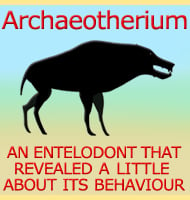In Depth about Pyrotherium
Pyrotherium was a fairly large and heavily built quadrupedal mammal that seems to have been similar to primitive elephants that were living in other parts of the world.
This is yet another case of convergent evolution that is displayed by South American mammals which during this time would have been living upon a continent that was isolated from the rest of the world.
Other examples include later litopterns such a Theosodon which resembled a primitive horse and Macrauchenia which looked like a bizarre camel.
Pyrotherium’s anatomy suggests it was a herbivore, with strong teeth adapted for grinding tough vegetation, likely in marshy or forested areas.
Pyrotherium possesses highly modified incisors that grew into short tusks that extended from both upper (two pairs) and lower jaws (one pair).
The anterior portion of the skull is also shaped so that a short trunk grew from the end of the snout.
Together Pyrotherium would have used the tusks to root up plants and then manipulate them into its mouth with the trunk.
Once inside the molar teeth at the back of the mouth would process the food before it was swallowed.
Pyrotherium When Was it Alive?
Pyrotherium, an extinct genus of large, elephant-like mammals, lived during the Late Eocene to Early Oligocene epochs, roughly 37 to 23 million years ago.
It inhabited South America, particularly regions that are now Argentina and possibly neighbouring areas.
Fossil Evidence
The most notable fossils of Pyrotherium have been found in the Deseadan South American Land Mammal Age (SALMA), providing insight into its existence during this time frame.
Further Reading
- – Sur les oiseaux fossiles de Patagonie; et la faune mammalogique des couches à Pyrotherium. – Boletin del Instituto Geographico Argentino 15:501-660. – F. Ameghino – 1894.
- – Mammiféres crétacés de l’Argentine (Deuxième contribution à la connaissance de la fauna mammalogique de couches à Pyrotherium) [Cretaceous mammals of Argentina (second contribution to the knowledge of the mammalian fauna of the Pyrotherium Beds)]. – Boletin Instituto Geografico Argentino 18(4–9):406-521. – F. Ameghino – 1897.
- – Notices préliminaires sur des ongulés nouveaux des terrains crétacés de Patagonie [Preliminary notes on new ungulates from the Cretaceous terrains of Patagonia]. – Boletin de la Academia Nacional de Ciencias de Córdoba 16:349-429. – F. Ameghino – 1901.
- – Pyrotherium macfaddeni, sp. nov. (late Oligocene, Bolivia) and the pedal morphology of pyrotheres. – Journal of Vertebrate Paleontology 24(2):481-488. – B. J. Shockey & F. Anaya-Daza – 2004.
- – Enamel microstructure and mastication in Pyrotherium romeroi (Pyrotheria, Mammalia). Paläontologische Zeitschrift 89: 611–634. – W. Koenigswald, T. von Martin & G. Billet – 2015.
Article History
- Published on 2nd July, 2014
- Added Further Reading Section on 5th May, 2021 (Updated)
- Added Para Pyrotherium when was it alive on 21st Nov, 2024
- Added Para Fossil Evidence on 27th Nov, 2024
- Updated and Re-Verified on 29th Nov, 2024








